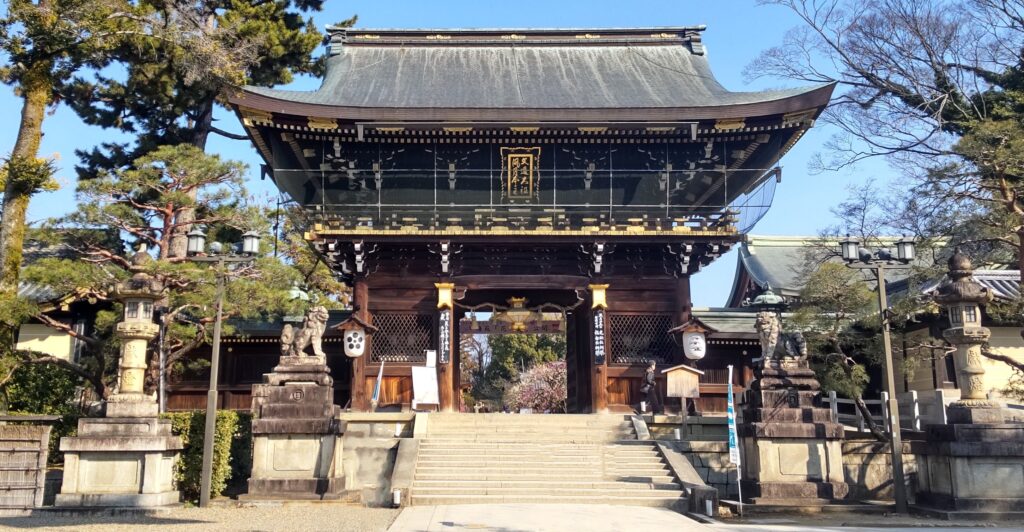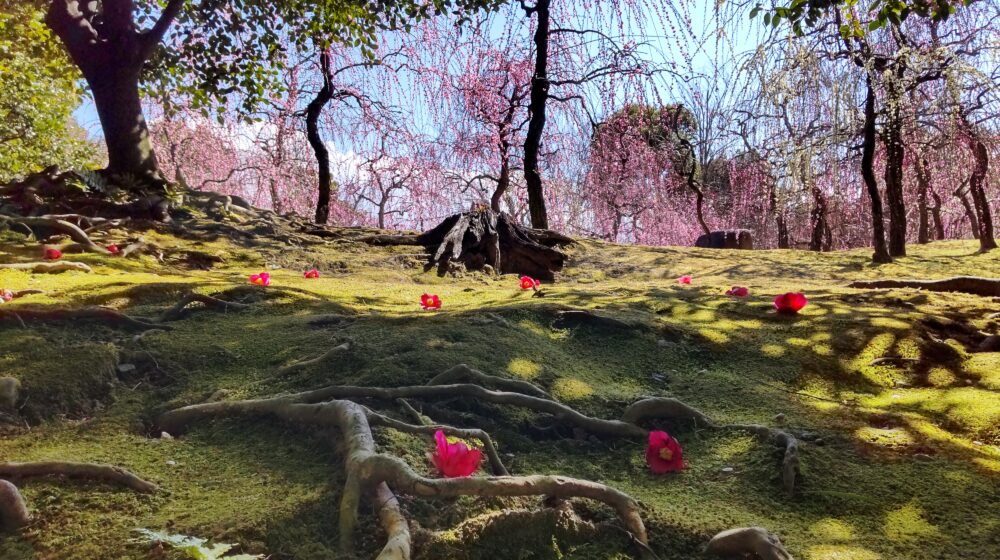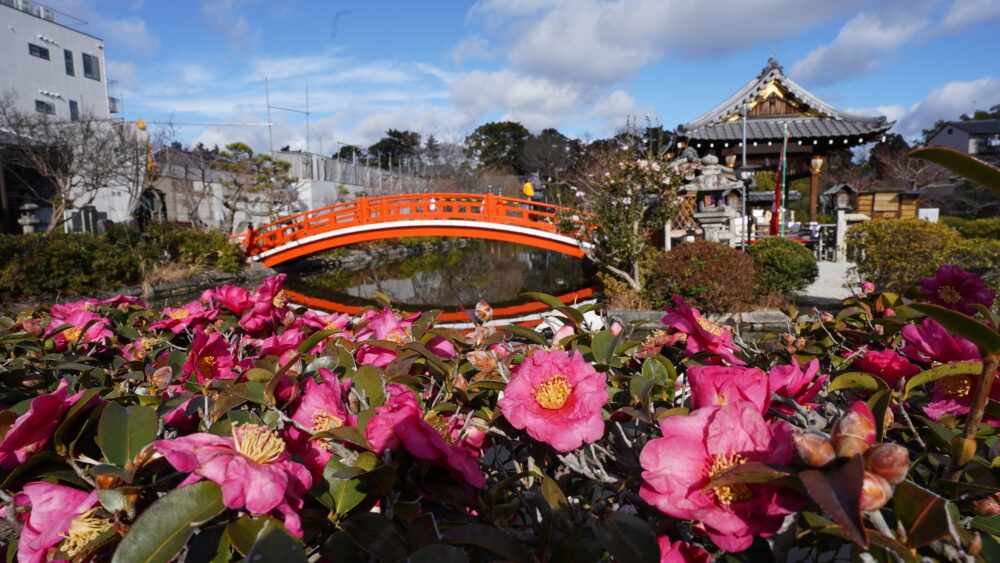Kitano Tenmangu Shrine | All You Need to Know in 2025

Kitano Tenmangu Shrine is the head shrine of all Tenmangu shrines – some 12,000 in all – throughout Japan, and it enshrines Sugawara no Michizane. Revered as the god of learning, it’s a popular destination for students praying for academic success, especially before exams.
This shrine has a beautiful plum orchard, a nod to Michizane’s love of plum blossoms.In addition, there are more than 350 maple trees in the Momiji-en (maple garden), making it a popular place for fall foliage.
History

Sugawara no Michizane (845-903) was a statesman during the Heian period who rose to the position of Minister of Right, but was unjustly exiled and subsequently died. After his death, a series of natural disasters and epidemics occurred, leading to rumors that these calamities were caused by Michizane’s vengeful spirit.
In 947, the Kitano Tenmangu Shrine was built to appease Michizane’s spirit. In 1004, Emperor Ichijo made an imperial visit to the shrine. In 1587, Toyotomi Hideyoshi held a grand tea ceremony (Grand Kitano Tea Ceremony) at the shrine.
Michizane was known as a literary scholar during his lifetime, and during the Edo period, his portrait was displayed in terakoya (public educational institutions). Today, the shrine is popular with students seeking academic success, and students from all over Japan visit to pray before exams.
Features
Kitano Tenmangu Shrine has a rich history of about 1,100 years, during which various historical buildings have been constructed.
Honden (Main Hall)

The Main Hall, where Sugawara no Michizane is enshrined, and the Haiden (Worship Hall) are connected by a stone-paved corridor, creating a unique structure. Built in 1607 by Toyotomi Hideyori, it features elaborate decorations and intricate carvings that reflect the Momoyama culture of the time.
Sanko-mon Gate (Three-Light Gate)

This gate serves as the central gate to the main hall of the shrine. It is called Sanko-mon (Three Lights Gate) because it is said to have carvings of the sun, moon, and stars. However, it is a well-known mystery that there are actually no carvings of stars, which is why it is called the “starless Sanko-mon.
Homotsuden (Treasure Hall)
This building houses and displays valuable sacred treasures passed down through the Kitano Tenmangu Shrine, including swords, armor, and illustrated scrolls donated by the Imperial family, samurai warriors, and merchants.
Statues of Ox

Various statues of oxen can be found throughout the shrine grounds. These are believed to be messengers of the gods at Tenmangu shrines. There are several theories to explain this association, including the belief that Sugawara no Michizane was born in the year of the ox and on the day of the ox. Another legend says that after his death, an ox laid down and determined the location of his burial site. It is said that rubbing the part of an ox statue that corresponds to a part of your body that you wish to heal can bring about improvement.
Tobiume (Flying Plum)
The Tobiume is a special plum tree planted in front of the main hall. It is believed to be a variety actually grown by Sugawara no Michizane and carefully passed down through generations. The legend of Tobiume tells how this tree miraculously flew from Kyoto to Dazaifu when Michizane, in exile, composed a waka poem longing for his beloved plum trees in Kyoto. However, the tobiume at Kitano Tenmangu and the tobiume at Dazaifu Tenmangu are different varieties and bloom at different times.
The tobiume at Kitano Tenmangu blooms with pink flowers from late February to early March, while the tobiume at Dazaifu Tenmangu blooms from mid to late January.
Beautiful Gardens
Kitano Tenmangu Shrine is known for two main gardens.
Hana no Niwa(Plum Garden)

Sugawara no Michizane was so fond of plum blossoms that he composed numerous waka poems about them and grew a unique variety known as “Tobiume”. In honor of Michizane, Kitano Tenmangu Shrine not only preserves Tobiume, but also cultivates approximately 1,500 plum trees of 50 different varieties in its vast 80,000 ft2 (6,600 m2) plum grove. The plum blossoms from the beginning of January to the end of March, with different varieties blooming one after the other.
Along the walking paths, visitors can admire a vibrant array of plum blossoms, including white and red plum blossoms, as well as 5-petaled and more than 15-petaled. From the observation deck on the south side, visitors can enjoy a panoramic view of the plum trees from above. A tea house on the north side offers a place to relax and enjoy the blossoms while enjoying tea and sweets.
Within the plum grove is a “Kyokusui” (winding stream), an artificial stream with a meandering design that originated in China. This feature includes stone bridges for crossing the stream, a pebble area designed to resemble a suhama (sandy beach), and stone lanterns that illuminate the paths. In addition to plum trees, Japanese red pines are also planted in the grove, contributing to the beautiful Japanese garden design.
Momiji-en (Maple Garden)

On the west side of Kitano Tenmangu Shrine, Toyotomi Hideyoshi constructed earthen ramparts known as “Odoi” to control flooding. Part of these walls remain today, and the area on the west side of the shrine grounds, long a natural forest with both naturally growing and later planted trees, is now a famous fall foliage site known as the Historic Site Odoi Maple Garden.
There is a vermilion-painted arched bridge called Uguisubashi that spans the Kamiya River. Due to the mild winter in 2024, the peak of the maple leaves’ autumn colors occurred from late November to early December. It is predicted that the leaves will peak around the same time in 2025.
Information
Open Hours
Main Shrine
7:00 a.m. – 5:00 p.m.
Shrine Office and Gift Shop
9:00 a.m. – 4:00 p.m.
Entrance Fee
Free
Adress
Bakurocho, Kamigyo Ward, Kyoto, 602-8386
Festivals and Events
- Baikasai
Baikasai is an annual festival held on February 25 in memory of Sugawara no Michizane, a scholar revered for his love of plum blossoms. During the festival, plum blossoms are offered at the main shrine and a purification ritual is performed. - Tenjin-ichi
Tenjin-ichi is an antique market held on the grounds of the Kitano Tenmangu Shrine. The date is significant because it marks both the birthday and the death anniversary of Sugawara no Michizane, the deity enshrined in the shrine. From early morning until sunset on the 25th, numerous stalls line the shrine grounds, attracting large crowds. Tenjin-ichi is considered one of the two major fairs, along with the Hongan-ji Temple Fair, and is known for its wide range of antiques, old tools, and vintage clothing.
Link & Resource
Official Website
Kitano Tenmangu Shrine(English Text)


